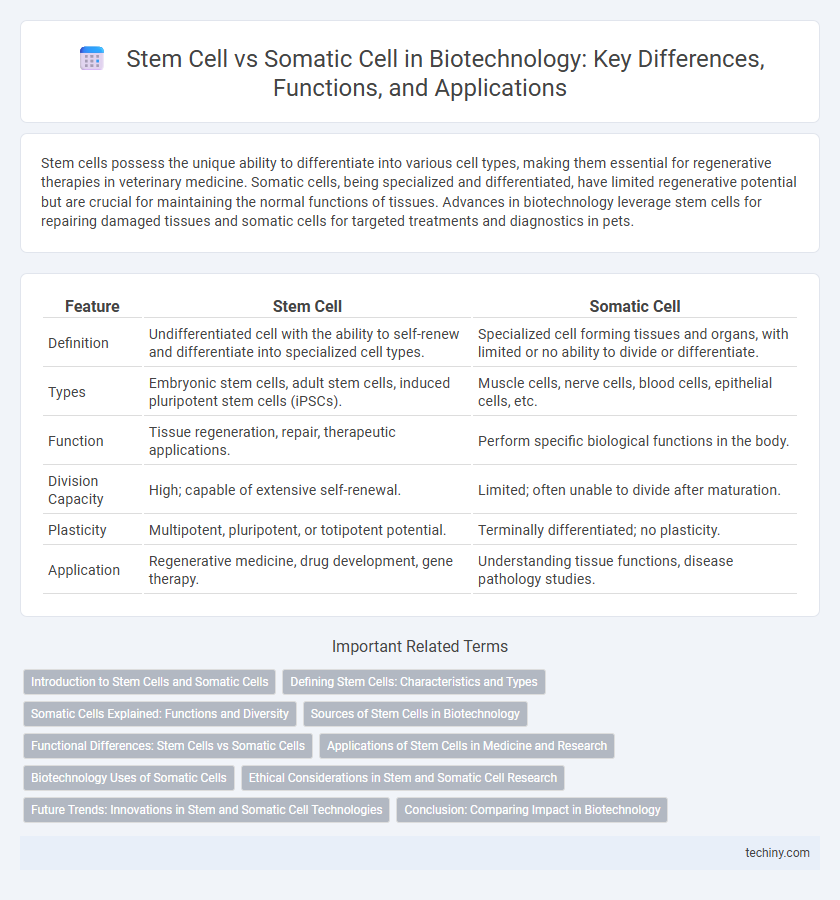Stem cells possess the unique ability to differentiate into various cell types, making them essential for regenerative therapies in veterinary medicine. Somatic cells, being specialized and differentiated, have limited regenerative potential but are crucial for maintaining the normal functions of tissues. Advances in biotechnology leverage stem cells for repairing damaged tissues and somatic cells for targeted treatments and diagnostics in pets.
Table of Comparison
| Feature | Stem Cell | Somatic Cell |
|---|---|---|
| Definition | Undifferentiated cell with the ability to self-renew and differentiate into specialized cell types. | Specialized cell forming tissues and organs, with limited or no ability to divide or differentiate. |
| Types | Embryonic stem cells, adult stem cells, induced pluripotent stem cells (iPSCs). | Muscle cells, nerve cells, blood cells, epithelial cells, etc. |
| Function | Tissue regeneration, repair, therapeutic applications. | Perform specific biological functions in the body. |
| Division Capacity | High; capable of extensive self-renewal. | Limited; often unable to divide after maturation. |
| Plasticity | Multipotent, pluripotent, or totipotent potential. | Terminally differentiated; no plasticity. |
| Application | Regenerative medicine, drug development, gene therapy. | Understanding tissue functions, disease pathology studies. |
Introduction to Stem Cells and Somatic Cells
Stem cells possess the unique ability to self-renew and differentiate into various specialized cell types, making them pivotal in regenerative medicine and tissue engineering. Somatic cells, on the other hand, are differentiated cells that constitute the body's tissues and organs, lacking the capacity for extensive division or pluripotency. Understanding the fundamental differences between stem cells and somatic cells is crucial for advancing biotechnological applications in disease treatment and cellular therapy.
Defining Stem Cells: Characteristics and Types
Stem cells possess the unique ability for self-renewal and differentiation into multiple specialized cell types, distinguishing them from somatic cells, which are mature and specialized with limited division capacity. Key stem cell types include embryonic stem cells, known for pluripotency and the ability to form all cell types, and adult stem cells, such as hematopoietic stem cells, which exhibit multipotency and contribute to tissue repair. Understanding these characteristics is critical for advancing regenerative medicine and developing targeted therapies.
Somatic Cells Explained: Functions and Diversity
Somatic cells constitute the majority of an organism's body cells, performing specialized functions such as muscle contraction, nerve signal transmission, and tissue repair, unlike stem cells which retain the ability to differentiate. These differentiated cells exhibit diverse structures and functions, including epithelial, connective, muscle, and nervous tissues, each essential for maintaining physiological homeostasis. Understanding somatic cell diversity aids advancements in regenerative medicine, targeted therapies, and cellular engineering within biotechnological research.
Sources of Stem Cells in Biotechnology
Embryonic stem cells, derived from the inner cell mass of blastocysts, provide pluripotent capabilities crucial for regenerative medicine and drug discovery. Adult stem cells, found in tissues like bone marrow, adipose tissue, and umbilical cord blood, offer multipotent properties facilitating targeted tissue repair and immune system support. Induced pluripotent stem cells (iPSCs), reprogrammed from somatic cells, combine the advantages of embryonic stem cells with patient-specific compatibility, advancing personalized therapies and disease modeling.
Functional Differences: Stem Cells vs Somatic Cells
Stem cells possess the unique ability to self-renew and differentiate into multiple cell types, enabling tissue regeneration and repair, unlike somatic cells, which are specialized and have limited division capacity. Somatic cells perform specific functions within tissues and organs, contributing to biological activities without the plasticity seen in stem cells. This functional distinction underpins stem cells' crucial role in developmental biology and regenerative medicine.
Applications of Stem Cells in Medicine and Research
Stem cells possess the unique ability to differentiate into various specialized cell types, making them invaluable in regenerative medicine for repairing damaged tissues and organs. In contrast to somatic cells, which are specialized and have limited division potential, stem cells can self-renew and generate diverse cell populations used in treatments for conditions such as neurodegenerative diseases, diabetes, and spinal cord injuries. Research applications also benefit from stem cells' pluripotency, enabling disease modeling, drug screening, and personalized medicine development.
Biotechnology Uses of Somatic Cells
Somatic cells play a critical role in biotechnology, particularly in therapeutic cloning, regenerative medicine, and gene therapy. These cells serve as a source for induced pluripotent stem cells (iPSCs), which can differentiate into various cell types for tissue engineering and disease modeling. Their use bypasses ethical concerns associated with embryonic stem cells, making somatic cells invaluable for developing personalized medicine and advanced treatment techniques.
Ethical Considerations in Stem and Somatic Cell Research
Ethical considerations in stem cell research revolve around the source of embryonic stem cells, raising debates on the moral status of embryos and consent issues. Somatic cell research generally presents fewer ethical dilemmas, as it involves differentiated cells obtained without embryo destruction. Regulatory frameworks emphasize informed consent, donor privacy, and the potential for therapeutic benefits while addressing concerns about human cloning and genetic modification.
Future Trends: Innovations in Stem and Somatic Cell Technologies
Emerging innovations in stem cell technology, such as induced pluripotent stem cells (iPSCs), offer unprecedented potential for personalized regenerative medicine by enabling the generation of patient-specific cell lines. Advances in somatic cell genome editing using CRISPR-Cas9 and base editors accelerate targeted therapies for genetic disorders while minimizing off-target effects. Integration of artificial intelligence and high-throughput screening optimizes differentiation protocols and enhances scalability for clinical applications in both stem and somatic cell research.
Conclusion: Comparing Impact in Biotechnology
Stem cells offer unparalleled versatility in regenerative medicine and therapeutic applications due to their ability to differentiate into multiple cell types, unlike somatic cells which have limited regenerative potential. The adaptability of stem cells drives innovation in tissue engineering and disease modeling, positioning them as a cornerstone in biotechnology advancements. Somatic cells contribute primarily to targeted therapies and genetic studies, but their impact remains confined compared to the broad utility of stem cells in medical research and clinical treatments.
stem cell vs somatic cell Infographic

 techiny.com
techiny.com